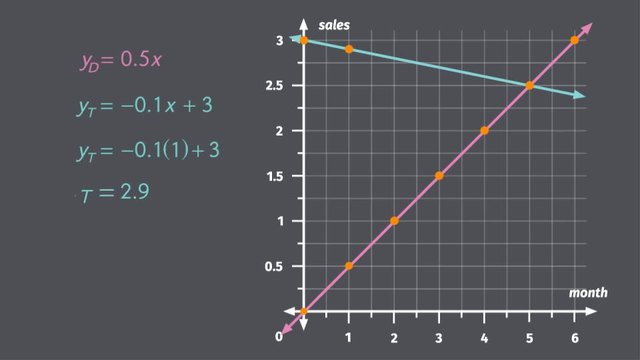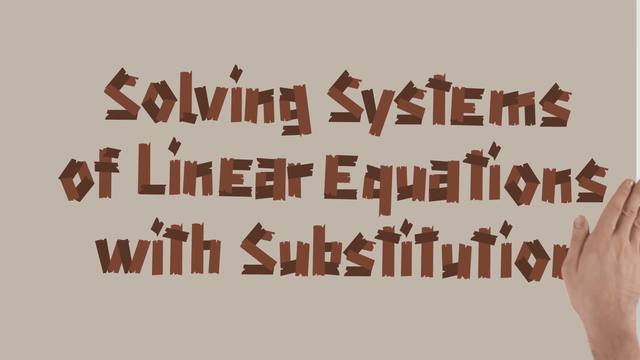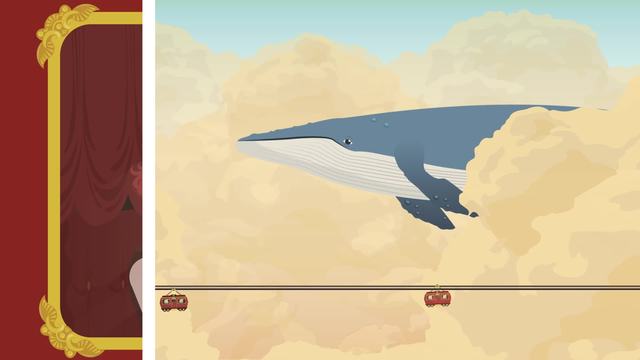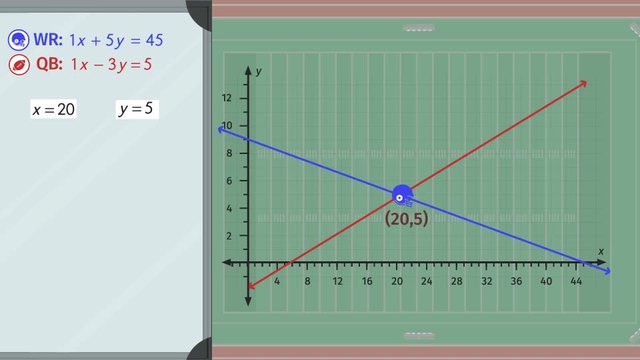Nature of Solutions of a System of Linear Equations


Basics on the topic Nature of Solutions of a System of Linear Equations
A system of linear equations in two variables can have one solution, no solution, or infinitely many solutions. The slopes and y-intercepts of the linear equations can be used to determine the number of the solutions the system of linear equations has. Learn about the different types of solutions to a system of linear equations in two variables by accompanying Little Jimmy and Uncle Mike on their first sushi-eating adventure in the city’s oldest Japanese restaurant. Common Core Reference: CCSS.MATH.CONTENT.8.EE.C.7.A
Transcript Nature of Solutions of a System of Linear Equations
Little Jimmy is an adventurous eater, and he's always wanted to try sushi. So, his uncle Mike acquiesces, and takes little Jimmy to the city's oldest Japanese restaurant for his birthday. Uncle Mike's relieved when he sees that, even though it's sushi, it's not that expensive. Who's bill will be higher, Jimmy's or Mike's? Let’s help our hungry eaters figure that out by examining the Types of Solutions to Systems of Linear Equations. Looking at the menu, we can see that adults pay $10 for the buffet and kids pay $8, plus either 20 or 30 cents per plate of sushi, depending on what you choose. Uncle Mike isn’t an adventurous eater, so he decides to go for the safest-looking sushi at $0.20 a plate. Jimmy's only interested in the fancy sushi, so he decides to go for the $0.30 plates. After how many plates will the price for Mike be the same as the price for Jimmy? Let’s take a look at a graph to find out. On our graph, we have plates of food on the x-axis and cost on the y-axis. Why did we choose the plates of food for the x-axis? Since we can choose how many plates of sushi to eat, it's the independent variable. And we usually put the independent variable on the x-axis. Let's write an expression for the total cost for Mike, the adult getting the cheaper sushi. We know that the fixed cost is $10 for the buffet and we know that ‘x’ is the number of plates, which we need to multiply by the cost of each plate, $0.20. If Mike ends up not liking sushi and only eats one plate, the total cost will be $10.20, but if he tries it twice and quits, two plates will total $10.40, and so on. We can write a similar expression for the total cost of Jimmy's plate. We know that the fixed cost is $8 for the buffet and $0.30 per plate. If Jimmy eats 5 plates, the total cost will be $9.50. Ten plates will total $11, and so on, and so on. We can see graphically that the two lines intersect at x = 20. This means that the cost of Uncle Mike and little Jimmy's meals will be equal after 20 plates. But is there a way to find this out algebraically? We want to find out when the cost for Mike is the same as the cost for Jimmy, so we write the equation for Mike, 10 + 0.20 times 'x', equals the equation for Jimmy, 8 plus 0.30 times 'x'. First, we want the variable 'x' on only one side, and then we isolate it using opposite operations and bring the 10 over to the other side. Dividing both sides by negative 0.10 gives us 'x' is equal to 20. But what if Mike is more adventurous and also goes for the more expensive sushi? The equation for Jimmy stays the same, 'y' equals 8 plus 0.30x. But the equation for the adventurous Uncle Mike becomes 'y' equals 10 plus 0.30x. After how many plates will Jimmy and Mike's meals cost the same? Let’s adjust our graph for Mike. We start at 10 and add 0.30 for the first plate, and for the second, and so on. Hmmm...these lines don’t look like they’re ever going to meet. Let’s set the equations equal to each other and check just to make sure. Look what happens when we try to isolate the variable. We find that 10 = 8. Whenever the coefficients in front of the variable are the same sign and the same value on opposite sides of the equal sign, it indicates that the lines are parallel and will never meet. Uncle Mike and little Jimmy are having such a good time, they're planning on coming back for the restaurant's International Sushi Day special. All customers pay $9 to get in, and all sushi plates cost $0.25. So the equation for Uncle Mike will be 'y' equals 9 plus 0.25x, and the equation for little Jimmy will also be 'y' equals 9 plus 0.25x. If we plug in numbers for 'x' and graph the results, we see that adults and kids will always pay the same price if they eat the same number of plates. Remember, if the slope and the intercept are both the same, the lines are also the same, which means there are infinite solutions to this system of linear equations. Okay, to review quickly. We start with two lines, each with the equation 'y' equals mx plus 'b'. Some equations give lines that have different slopes and meet at exactly one point. This means there is one solution. Some equations give lines that have the same slope, but have different 'b' values. These lines are parallel and never meet, which means this system of equations has no solution. And some equations give lines that have the same slope and the same 'b' values. This means there are an infinite number of solutions. Let’s get back to our birthday boy Jimmy and his Uncle Mike. That’s a huge stack of plates! The waitress goes to print out the bill and…how much sushi did they eat?!?!
Nature of Solutions of a System of Linear Equations exercise
-
Explain how to find the solution to the system of equations.
HintsA linear equation is often written in the form: $y=mx+b$.
In this case, $m$ is the slope and $b$ the y-intercept.
If two linear equations have the same slope, they are parallel.
- If the y-intercepts differ, the lines will never meet.
- If the y-intercepts are the same, the lines are the same.
SolutionLooking at the menu we can see the prices:
- Adults have to pay $\$~10$ to enter and kids $\$~8$.
- The normal sushi costs $20$ cents and the fancy sushi $30$ cents per plate.
The non-adventurous uncle Mike
$y=10+0.20x$ The adventurous Jimmy
$y=8+0.3x$
Identifying those equations leads to a linear equation:
$\begin{array}{rcl} 10+0.20x & = & ~8+0.30x\\ \color{#669900}{-0.30x} & &\color{#669900}{-0.30x}\\ 10-0.10x & = & ~8\\ \color{#669900}{-10} & & \color{#669900}{-10}\\ -0.10x & = & ~-2\\ \color{#669900}{\div (-0.10)} & & \color{#669900}{\div (-0.10)}\\ x & = & ~20 \end{array}$
The two lines intersect at $x=20$ and $y=10+0.20\times 20=14$.
If Mike decides to take the fancy sushi, the resulting equation is a bit different:
$y=10+0.30x$
Have a look at the slope of the equations for Jimmy and Mike. They have the same slope: $m=0.30$ but different y-intercepts. The two lines are parallel and never meet.
If the restaurant offers a special day with the same buffet price for adults and kids, and the same price for all types of sushi plates, the corresponding price would be given by $y=9+0.25x$
Here we can see that the slope and y-intercept are the same for both adults and kids.
The corresponding lines are the same, so they have infinitely many points in common.
-
Find the graph which corresponds to the system of equations.
HintsGiven an equation in this form $y=mx+b$, here are what the parameters stand for:
- $m$ is the slope
- $b$ is the y-intercept
- A positive slope leads to an increasing line.
- A negative slope leads to a decreasing line.
SolutionTo detect which line corresponds to a given equation, first look at the y-intercept: This is where the line passes the y-axis.
Let's start with the red line passing through the origin. Thus $b=0$. The corresponding equation is given by $y=x$.
Next, we examine the blue line crossing the y-axis at $3.5$. The slope is negative. So the corresponding line must be $y=3.5-0.5x$.
The green line crosses the y-axis at $1$ and is increasing: The corresponding equation is given by $y=1+0.5x$.
Last, we consider the orange line crossing the y-axis at $-0.5$. The line is increasing: $y=-0.5+1.5x$.
-
Determine which systems of equations have one, infinitely many, or no solutions.
HintsTwo equations with different slopes, $m$, have only one point in common.
Two equations with the same slope, represented by $m$, have either no points or infinitely many points in common.
This depends on the y-intercept.
Take a look at this example:
- The slope $m=2$ is the same.
- The y-intercepts are different. So the lines have no points in common.
SolutionThe type of solutions of a system of linear equations depends on the slope and the y-intercept:
- If both are the same, the lines have infinitely many points in common.
- If just the slopes are the same, the lines are parallel and thus have no points in common.
- If the slopes are different, there is just one point in common.
One solution
- $y=2x+3$; $y=3x+2$
- $y=0.5x$; $y=-0.5x+2$
No solution
- $y=2x+3$; $y=2x+2$
- $y=0.5x$; $y=0.5x+2$
Infinitely many solutions
- $y=2x+3$; $y=2x+3$
- $y=0.5x$; $y=0.5x$
-
Graph the system of equations and find the solution(s), if any exist.
HintsTo draw a line corresponding to a given linear equation, first draw the the y-intercept in a coordinate plane.
Starting at the y-intercept, you can use rise over run to draw the slope of the line.
The given lines have one point in common.
You can determine this point algebraically by solving the equation $12+0.40x=9+0.60x$.
Just plug the given points in the equations to check if they are on the correct lines.
SolutionThe line $y=12+0.40x$ is the blue one and the line $y=9+0.60x$ is the red one.
You can recognize those lines by first looking at the y-intercept and checking the given points after.
The intersection of those lines, and thus the solution of the system of equations, is $(15,18)$.
You can determine this solution algebraically:
$\begin{array}{rcl} 12+0.40x & = & ~9+0.60x\\ \color{#669900}{-0.60x} & &\color{#669900}{-0.60x}\\ 12-0.20x & = & ~9\\ \color{#669900}{-12} & & \color{#669900}{-12}\\ -0.20x & = & ~-3\\ \color{#669900}{\div (-0.20)} & & \color{#669900}{\div (-0.20)}\\ x & = & ~15 \end{array}$
Finally, you get the y-coordinate of the solution by plugging this value in one of the given equations. It doesn't matter which one you choose:
$y=12+0.40\times 15=12+6=18$ $~~~~~$✓
-
Identify which statements are true.
HintsHere you see two lines with different slopes and different y-intercepts.
Any two given lines have either one point, no points or infinitely many points in common.
SolutionThe type of solutions to systems of linear equations depends on the slope as well as the y-intercept of the equations:
Let's have two equations
$y=m_1x+b_1$ and
$y=m_2x+b_2$
First, let's have a look at the slope of the lines:
- $m_1\neq m_2$ $\rightarrow$ the lines have one point in common independently on the y-intercept.
- $m_1=m_2$
- $b_1=b_2$ $\rightarrow$ the lines are identical and thus have infinitely many points in common.
- $b_1\neq b_2$ $\rightarrow$ the lines are parallel and never meet. They have no points in common.
-
Find the solution(s), if any exist, to the system of equations.
HintsIf necessary, transform the equation into the form:
$y=mx+b$.
- If only the slope of two equations is the same, the lines are parallel and never meet. So you get no solution.
- If both the slope and the y-intercept are the same, there are infinitely many solutions.
If two equations have different slopes you get the unique solution by setting the $y$ variables equal to each other and solving for $x$.
SolutionTo check which type of solution two (or more) equations have, we just examine the slope and the y-intercept:
- If both are the same, there are infinitely many solutions.
- If just the slope is the same, there exist no solutions.
Form left to the right:
The farthest to the left: The slope $m=2$ is the same but the y-intercepts differ. Thus this system has no solution.
The second equations from the left: The first and the second equation are the same. The third one has a different slope, so you get the solution solving the following equation:
$\begin{array}{rcl} 0.5x+10 & = & ~-0.5x-10\\ \color{#669900}{+0.5x} & &\color{#669900}{+0.5x}\\ x+10 & = & ~-10\\ \color{#669900}{-10} & & \color{#669900}{-10}\\ x & = & ~-20 \end{array}$
This leads to $y=0.5\times (-20)+10=-10+10=0$
The equations in the middle: This system of equations also has a unique solution.
$\begin{array}{rcl} -2x-5 & = & ~2x+3\\ \color{#669900}{-2x} & &\color{#669900}{-2x}\\ -4x-5 & = & ~3\\ \color{#669900}{+5} & & \color{#669900}{+5}\\ -4x & = & ~8\\ \color{#669900}{\div(-4)} & & \color{#669900}{\div(-4)}\\ x & = & ~-2 \end{array}$
Again, we get $y$ by plugging in the value of $x$ we found into either of the two equations:
$\quad~~~y=2\times (-2)+3=-4+3=-1$
The second equations from the right: Just look at the equations:
$\begin{array}{rcl} y&=&~2x+3\\ 2y-4x&=&~-6 \end{array}$
What's that? The second equation looks a little different from the first one. So we first transform this equation:
- Add $4x$ to get $2y=4x-6$.
- Divide by $2$. This leads to $y=2x-3$.
The equations to the far right: If you multiply the second equation by $-1$ you just get the first one. So both equations are the same. Thus, this system has infinitely many solutions.
















